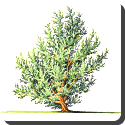 Juniper, Common — Junipers are coniferous plants in the genus Juniperus of the cypress family Cupressaceae. Depending on taxonomic viewpoint, there are between 50-67 species of juniper, widely distributed throughout the northern hemisphere, from the Arctic, south to tropical Africa in the Old World, and to the mountains of Central America in the New World.
Juniper, Common — Junipers are coniferous plants in the genus Juniperus of the cypress family Cupressaceae. Depending on taxonomic viewpoint, there are between 50-67 species of juniper, widely distributed throughout the northern hemisphere, from the Arctic, south to tropical Africa in the Old World, and to the mountains of Central America in the New World.
Junipers vary in size and shape from tall trees, 20-40 m tall, to columnar or low spreading shrubs with long trailing branches. They are evergreen with either needle-like and/or scale-like leaves. They can be either monoecious or dioecious. The female seed cones are very distinctive, with fleshy, fruit-like coalescing scales which fuse together to form a “berry”-like structure, 4-27 mm long, with 1-12 unwinged, hard-shelled seeds. In some species these “berries” are red-brown or orange but in most they are blue; they are often aromatic (for their use as a spice, see juniper berry). The seed maturation time varies between species from 6-18 months after pollination. The male cones are similar to those of other Cupressaceae, with 6-20 scales; most shed their pollen in early spring, but some species pollinate in the autumn.
Juniper berries are a spice used in a wide variety of culinary dishes and best known for the primary flavoring in gin (and responsible for gin’s name, which is a shortening of the Dutch word for Juniper: genever). Juniper berries are also used as the primary flavor in the liquor Jenever and sahti-style of beers. Juniper berry sauce is often a popular flavoring choice for quail, pheasant, veal, rabbit and other meat dishes.
 Kids Portal For Parents India Kids Network
Kids Portal For Parents India Kids Network






